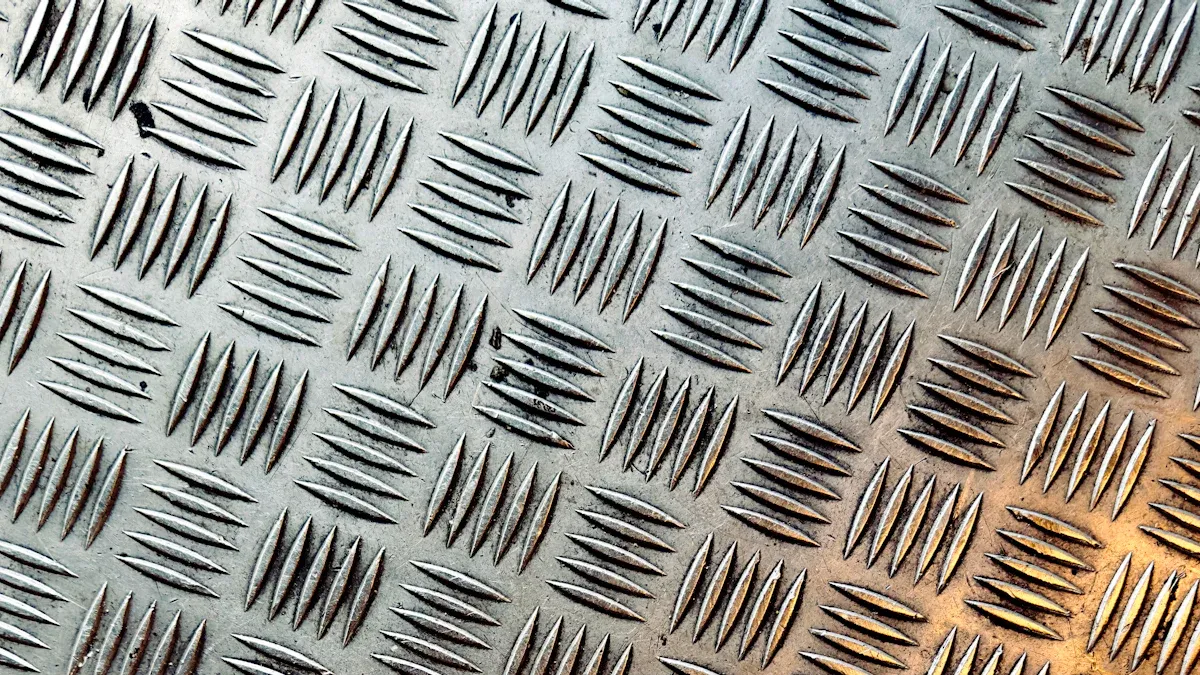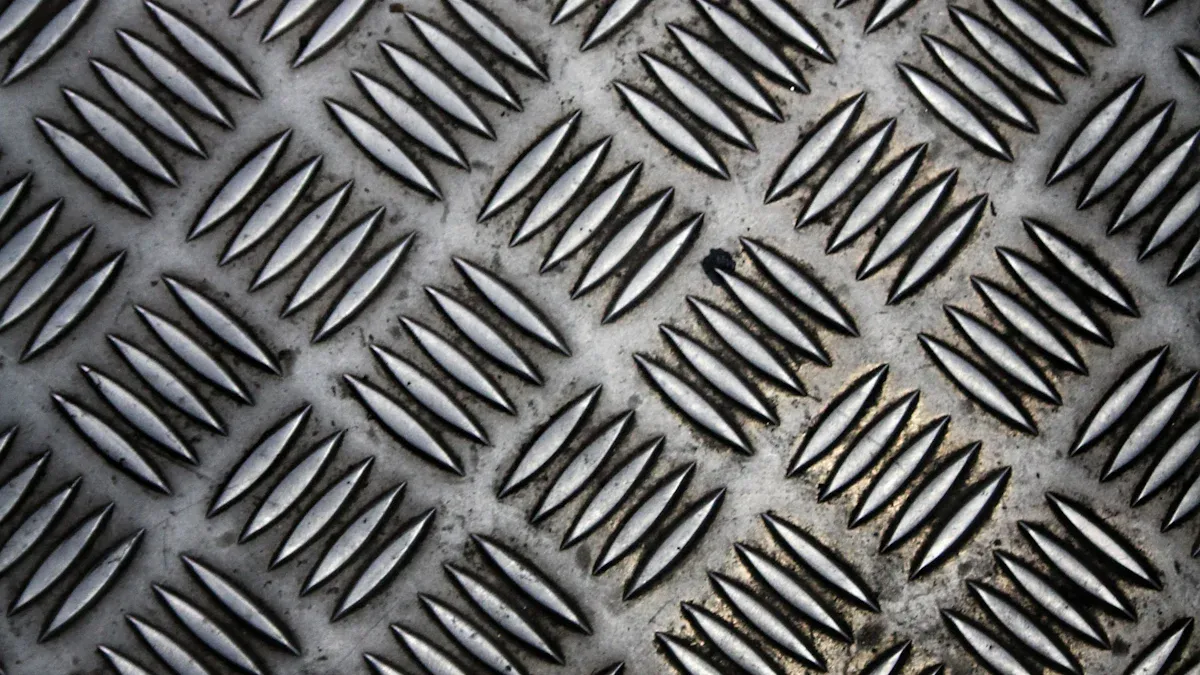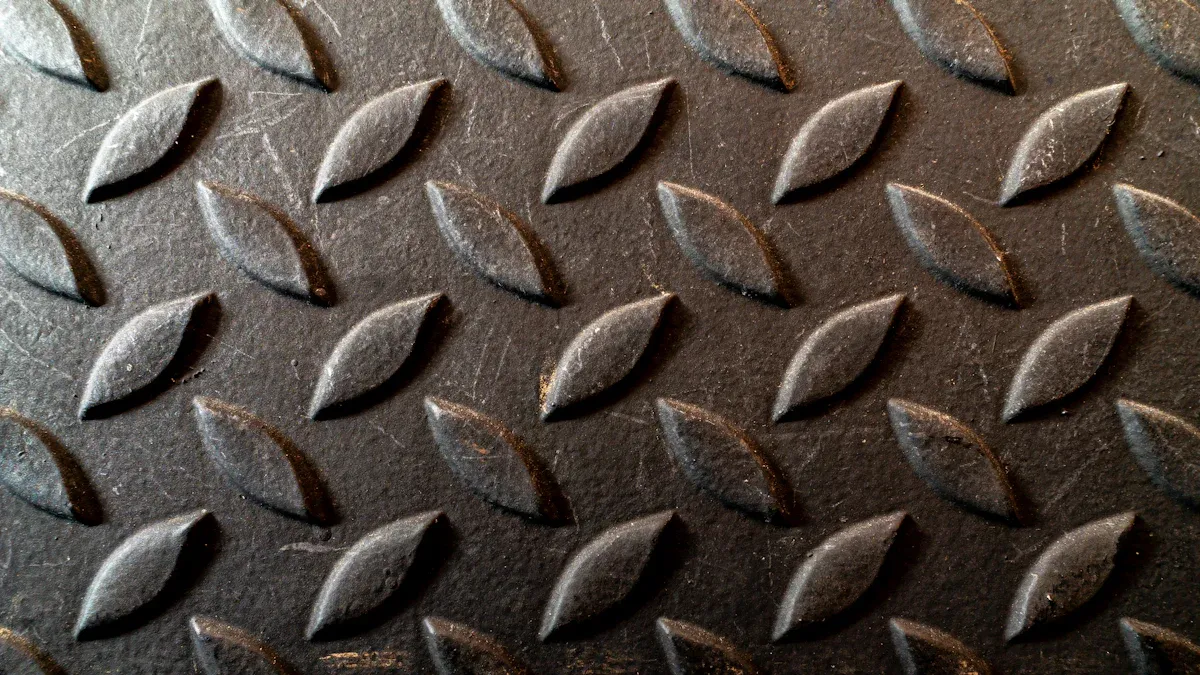
Marganets po'latiplitalar yuqori chidamlilik va ishlashni talab qiladigan sanoat ilovalarida hal qiluvchi rol o'ynaydi. Ularning noyob tarkibi, shu jumladan 11,5-15,0% marganets abraziv sharoitlarda ajoyib aşınma qarshiligini ta'minlaydi. ning tanlovimarganets po'latlari plitasihayotiy ahamiyatga ega, chunki noto'g'ri tanlash samaradorlikning pasayishiga va yuqori xarajatlarga olib kelishi mumkin. Sanoat uskunalarning ishlash muddatini uzaytirish va ish samaradorligini saqlab qolish uchun marganets po'lat plitalariga tayanadi, marganets po'latini turli sohalarda muhim materialga aylantiradi.
Asosiy xulosalar
- Marganets po'lat plitalari juda kuchli va eskirishga qarshilik ko'rsatadi. Ular konchilik va qurilish kabi ishlar uchun juda yaxshi.
- O'ngni tanlashmarganets po'lat plitalarichunki sizning ishingiz yaxshiroq ishlashiga yordam beradi va pulni tejashga yordam beradi.
- Sinov qismlari va mutaxassislardan so'rash sizga tanlashda yordam beradieng yaxshi marganets po'lat plitalariehtiyojlaringiz uchun.
Marganets po'lat plitalarini tushunish

Marganets po'lat plitalari nima
Marganets po'lat plitalari, ko'pincha Hadfield po'lati deb ataladi, o'zining ajoyib chidamliligi va aşınma qarshiligi bilan mashhur. Ularning noyob tarkibiga uglerod (0,8-1,25%) va marganets (12-14%) kiradi, asosiy asos sifatida temir mavjud. Ushbu kombinatsiya materialning qattiqlashuv jarayonini o'tkazishga imkon beradi, bu erda sirt ta'sirida qattiqlashadi va ichki egiluvchanlikni saqlaydi. Bu xususiyat marganets po'lat plitalarini qattiq aşınma va ta'sirga duchor bo'lgan muhitlar uchun ideal qiladi.
Marganets po'lat plitalarining metallurgik xususiyatlari ularning ish faoliyatini yanada oshiradi. Ushbu plitalar 950 dan 1400 MPa gacha bo'lgan kuchlanish kuchini va 350 dan 470 MPa gacha bo'lgan oqish quvvatini namoyish etadi. Ularning 25-40% cho'zilish qobiliyati stress ostida moslashuvchanlikni ta'minlaydi, 200-250 HB qattiqlik darajasi esa aşınmaya qarshilik ko'rsatadi. Quyidagi jadvalda asosiy komponentlar va xususiyatlar jamlangan:
| Komponent | Foiz |
|---|---|
| Marganets (Mn) | 11–14% |
| Uglerod (C) | 1,0–1,4% |
| Kremniy (Si) | 0,3–1,0% |
| Fosfor (P) | ≤ 0,05% |
| Oltingugurt (S) | ≤ 0,05% |
| Mulk | Qiymat |
|---|---|
| Mustahkamlik chegarasi | 950–1400 MPa |
| Hosildorlik kuchi | 350–470 MPa |
| Cho'zilish | 25–40% |
| Qattiqlik | 200–250 HB |
Ushbu xususiyatlar marganets po'lat plitalarini ekstremal sharoitlarga bardosh bera oladigan materiallarni talab qiladigan sohalarda ajralmas qiladi.
Marganets po'lat plitalarining umumiy qo'llanilishi
Marganets po'lat plitalari og'ir muhitlarga bardosh berish qobiliyati tufayli sanoatning keng doirasiga xizmat qiladi. Ularning ilovalariga quyidagilar kiradi:
- Konchilik va karer qazish: Tosh maydalagichlar va bolg'alar ularning ta'sirga chidamliligidan foyda ko'radi, bu esa xizmat muddatini uzaytiradi.
- Temir yo'l sanoati: Temir yo'l kesishmalari kabi komponentlar og'ir yuklarni ko'tarish va ish xavfsizligini ta'minlash uchun marganets po'lat plitalariga tayanadi.
- Qurilish: Ekskavator chelaklari va yuk ko'taruvchi tishlari eskirishga qarshi turish va texnik xizmat ko'rsatish xarajatlarini kamaytirish uchun ushbu plitalardan foydalanadi.
- Parchalash va qayta ishlash: Metall maydalagichlar doimiy ishqalanish ostida chidamliligi uchun marganets po'lat plitalariga bog'liq.
- Dengiz sanoati: Ularning aşınmaya va korroziyaga chidamliligi ularni dengiz suvi ilovalari uchun mos qiladi.
Amaliy tadqiqotlar muayyan sohalarda ularning chidamliligini ta'kidlaydi. Misol uchun, tog'-kon sanoatida marganets po'lat plitalari ishqalanish va ta'sirga qarshi turish orqali tosh maydalagichlarning ishlash muddatini uzaytiradi. Qurilishda ular ekskavator chelaklarida eskirishni kamaytirish orqali ishlamay qolish vaqtini kamaytiradi. Quyidagi jadval turli sohalarda ularning chidamlilik atributlarini ko'rsatadi:
| Sanoat/Ilova | Chidamlilik atributi |
|---|---|
| Qurilish | Ekskavator paqirlari va yuk ko'taruvchi tishlarida yuqori aşınma qarshilik, ishlamay qolish va texnik xizmat ko'rsatish xarajatlarini kamaytiradi. |
| Temir yo'l | Kalitlar va o'tish joylarida ta'sirga chidamlilik, operatsiyalarda ishonchlilik va xavfsizlikni ta'minlash. |
| Konchilik | Tosh maydalagichlarda yuqori qattiqlik, ishqalanish va ta'sirga qarshi xizmat muddatini uzaytiradi. |
| Dengizchi | Dengiz suvida aşınma va korroziyaga chidamlilik, uzoq muddatli ishlashni ta'minlaydi. |
| General | Ishda qattiqlashuvchi xususiyat yuqori aşınma muhitida chidamlilikni oshiradi. |
Ushbu ilovalar marganets po'lat plitalarining qiyin sharoitlarda ko'p qirrali va ishonchliligini namoyish etadi.
Marganets po'lat plitasini tanlashda e'tiborga olish kerak bo'lgan omillar

Sanoatga xos talablar
Turli sohalarda marganets po'lat plitalari uchun noyob talablar mavjud. Tog'-kon va karerlarni qazish ishlari tosh va minerallarning doimiy ishqalanishiga bardosh beradigan plitalarni talab qiladi. Misol uchun, maydalagich jag'lari va grizzly ekranlar ekstremal sharoitlarda ishlashni saqlab qolish uchun materialning mustahkamligiga tayanadi. Qurilishda buldozer paqir pichoqlari va boshqa tuproq ishlov berish mashinalari marganets po'lat plitalarining aşınma qarshiligidan foyda ko'radi va og'ir muhitda chidamlilikni ta'minlaydi. Temir sanoati bu plitalarni hidoyat plitalari va eskirish qoplamalarida ishlatadi, bu erda yuqori stress sharoitlari uzoq muddatli ishlashni talab qiladi.
Sanoatning o'ziga xos talablarini tushunish to'g'ri marganets po'lat plitasini tanlashga yordam beradi. Masalan, kon qazish ishlari zarba qarshiligiga ustunlik berishi mumkin, dengizda esa korroziyaga chidamliligiga e'tibor qaratish mumkin. Tanlovni dasturga moslashtirish optimal ishlash va iqtisodiy samaradorlikni ta'minlaydi.
Sifat va sertifikatlashtirish standartlari
Sifat standartlari va sertifikatlari marganets po'lat plitalarining ishlashi va ishonchliligini tasdiqlaydi. ISO 9001 kabi tan olingan sertifikatlar doimiy mahsulot sifati va mijozlar ehtiyojini qondirishni ta'minlaydi. ISO 4948 po'latlarni kimyoviy tarkibi va qo'llanilishi bo'yicha tasniflash bo'yicha ko'rsatmalar beradi, bu esa tegishli navni tanlashga yordam beradi.
Quyidagi jadvalda asosiy sertifikatlar ko'rsatilgan:
| Standart/sertifikatlash | Tavsif |
|---|---|
| ISO 9001 | Barqaror mahsulot sifati va mijozlar ehtiyojini qondirishni ta'minlaydi. |
| ISO 4948 | Cheliklarni kimyoviy tarkibi va qo'llanilishi bo'yicha tasniflaydi. |
| ISO 683 | Batafsil mexanik xususiyat talablari bilan issiqlik bilan ishlangan po'latlarni belgilaydi. |
| DIN 17100 | Uglerodli konstruktiv po'latlar uchun texnik xususiyatlarni tavsiflaydi. |
| DIN 1.2344 | Yuqori issiq ishlov berish va termal charchoqqa chidamlilik bilan asbob po'latlarini belgilaydi. |
Ushbu standartlarga javob beradigan plitalarni tanlash chidamlilik va ishlashni kafolatlaydi, muddatidan oldin ishdan chiqish xavfini kamaytiradi.
Yetkazib beruvchining obro'si va ishonchliligi
Yetkazib beruvchining obro'si marganets po'lat plitalarining sifatini ta'minlashda muhim rol o'ynaydi. Kuchli brend obro'siga ega ishonchli yetkazib beruvchi ko'pincha izchil va ishonchli mahsulotlarni yetkazib beradi. Sanoat so'rovlari shuni ko'rsatadiki, ijobiy obro'ga ega kompaniyalar mijozlarning sodiqligini oshiradi va yangi mijozlarni jalb qiladi. Bu ishonch ularning sifat kutganlarini qondirish va o'z vaqtida yetkazib berish qobiliyatidan kelib chiqadi.
Yetkazib beruvchilarni baholashda ularning tajribasini, mijozlar sharhlarini va sanoat standartlariga rioya qilishni hisobga oling. Ishonchli yetkazib beruvchi nafaqat yuqori sifatli plitalarni taqdim etadi, balki uzluksiz tajribani ta'minlaydigan texnik yordam va sotishdan keyingi xizmatni ham taklif qiladi.
Xarajat va uzoq muddatli qiymatni muvozanatlash
Marganets po'lat plitalari ixtisoslashgan ishlab chiqarish jarayonlari tufayli yuqori dastlabki xarajatlarga ega bo'lishi mumkin bo'lsa-da, ularning uzoq muddatli qiymati ko'pincha dastlabki xarajatlardan ustun turadi. Ushbu plitalar yuqori aşınma qarshilik va chidamlilikni ta'minlaydi, texnik xizmat ko'rsatish va almashtirish chastotasini kamaytiradi. Tog'-kon sanoati kabi og'ir ilovalarda kamroq almashtirish va kamroq ishlamay qolishdan tejamkorlik sezilarli bo'lishi mumkin.
Xarajat-foyda tahlili ongli qaror qabul qilishga yordam beradi. Masalan:
- Marganets po'lat plitalari maydalagich komponentlarining ishlash muddatini uzaytirish orqali konchilikda texnik xizmat ko'rsatish xarajatlarini kamaytiradi.
- Qurilishda ularning chidamliligi ishlamay qolish vaqtini kamaytiradi, bu esa yuqori mahsuldorlikka olib keladi.
Investitsiya qilishyuqori sifatli marganets po'lat plitalariuzoq muddatli tejash va ishonchli ishlashni ta'minlaydi, bu ularni talab qilinadigan ilovalar uchun tejamkor tanlovga aylantiradi.
To'g'ri marganets po'lat plitasini tanlash bo'yicha amaliy maslahatlar
Baholar va spetsifikatsiyalarni solishtirish
To'g'ri marganets po'lat plitasini tanlashuning darajalari va texnik xususiyatlarini tushunish bilan boshlanadi. Har bir daraja ma'lum ilovalarga moslashtirilgan noyob xususiyatlarni taklif etadi. Masalan, yuqori marganets miqdori aşınma qarshiligini oshiradi, pastroq uglerod darajasi esa egiluvchanlikni yaxshilaydi. Ushbu atributlarni taqqoslash sanoatga materialni ularning operatsion ehtiyojlariga moslashtirishga yordam beradi.
Texnik ma'lumotlar varaqlarini batafsil ko'rib chiqish valentlik kuchi, qattiqlik va cho'zilish haqida qimmatli ma'lumotlarni beradi. Ushbu ko'rsatkichlar plastinkaning stress va ta'sirga qarshi turish qobiliyatini aniqlaydi. Qabul qiluvchilar o'zlarining jihozlari bilan muvofiqligini ta'minlash uchun kimyoviy tarkibni ham hisobga olishlari kerak.
Maslahat: Ishlash umidlaridagi nomuvofiqlikni oldini olish uchun har doim etkazib beruvchilardan batafsil spetsifikatsiyalarni so'rang.
Namunalar so'rash va testlarni o'tkazish
Namunalarni sinovdan o'tkazish - bu ish faoliyatini baholashning amaliy usulimarganets po'lat plitalari. Namunalar sanoat korxonalariga haqiqiy sharoitlarda aşınma qarshilik, zarba kuchi va ishni qattiqlashtirish imkoniyatlarini baholash imkonini beradi. Sinovlarni o'tkazish materialning ommaviy xaridlarni amalga oshirishdan oldin operatsion talablarga javob berishini ta'minlaydi.
Umumiy sinovlarga qattiqlik sinovi, kuchlanish kuchini baholash va aşınma qarshilik tahlili kiradi. Ushbu testlar plastinkaning mo'ljallangan qo'llanilishida duch keladigan stresslarni simulyatsiya qiladi. Natijalar materialning ishonchliligi va chidamliligi haqida aniq tasavvur beradi.
Eslatma: Namunalarni sinovdan o'tkazish xavflarni kamaytiradi va tanlangan plastinkaning uzoq muddatli qiymatini ta'minlaydi.
Yo'l-yo'riq ko'rsatish uchun sanoat mutaxassislari maslahati
Sanoat mutaxassislari marganets po'lat plitalarini tanlashda qimmatli maslahatlar beradi. Ularning tajribasi xaridorlarga texnik xususiyatlarni tanlashda va muayyan ilovalar uchun eng yaxshi variantlarni aniqlashda yordam beradi. Mutaxassislar, shuningdek, ishonchli etkazib beruvchilarni tavsiya qilishlari va marganetsli po'lat texnologiyasida paydo bo'lgan tendentsiyalar haqida ma'lumot berishlari mumkin.
Mutaxassislarning maslahati ongli ravishda qaror qabul qilishni ta'minlaydi. Ularning ko'rsatmalari xatolar ehtimolini kamaytiradi va tanlov jarayonini optimallashtiradi. Sanoat ish faoliyatini yaxshilaydigan va xarajatlarni kamaytiradigan plitalarni tanlash orqali o'z tajribasidan foyda oladi.
Chaqirmoq; aniqlamoq: Mutaxassislar bilan ishlash vaqtni tejaydi va tanlovning operatsion maqsadlarga mos kelishini ta'minlaydi.
To'g'ri marganets po'lat plitalarini tanlash sanoatning o'ziga xos ehtiyojlarini samarali qondirishni ta'minlaydi. Aniqlangan qarorlar chidamlilikni oshirishga, ishlamay qolish vaqtini qisqartirishga va sezilarli xarajatlarni tejashga olib keladi. Sanoat ishlab chiqarishni yaxshilash, mahsulot o'lchamlarini yaxshilash va eskirish muddatini uzaytirishdan foyda ko'radi. Quyidagi jadval ushbu afzalliklarni ta'kidlaydi:
| Foyda | Tavsif |
|---|---|
| Yaxshilangan ishlab chiqarish | Maydalash jarayonining umumiy chiqishini yaxshilaydi. |
| Yaxshilangan mahsulot o'lchamlari | Yakuniy mahsulot sifatini ta'minlaydi. |
| Metalldan foydalanish yaxshiroq | Materiallardan maksimal darajada foydalanish, chiqindilarni kamaytirish. |
| Yo'qotilgan vaznni kamaytiring | Foydalanishga yaroqsiz material miqdorini kamaytiradi. |
| Uzunroq kiyinish muddati | Komponentlarning ishlash muddatini uzaytiradi. |
| Umumiy xarajatlarni kamaytirish | O'zgartirishlar bilan bog'liq xarajatlarni kamaytiradi. |
Belgilangan maslahatlarni qo'llash sanoatga operatsiyalarni optimallashtirish va uzoq muddatli muvaffaqiyatga erishish imkonini beradi.
TSS
Marganets po'lat plitalarini nima o'ziga xos qiladi?
Marganets po'lat plitalari ichki egiluvchanlikni saqlab, zarbadan qattiqlashadi. Bu kombinatsiya abraziv muhitda ajoyib aşınma qarshilik va chidamlilikni ta'minlaydi.
Sotib olishdan oldin sanoat marganets po'lat plitalarini qanday sinovdan o'tkazishi mumkin?
Sanoat korxonalari namunalarni so'rashi va ularning qo'llanilishiga yaroqliligini ta'minlash uchun qattiqlikni baholash, valentlik kuchini tahlil qilish va ishqalanish qarshiligini tekshirish kabi sinovlarni o'tkazishi mumkin.
Marganets po'lat plitalari uzoq muddatli foydalanish uchun tejamkormi?
Ha, ularning chidamliligi texnik xizmat ko'rsatish va almashtirish xarajatlarini kamaytiradi, bu ularni atejamkor tanlovyuqori aşınma va zarba talablari bo'lgan tarmoqlar uchun.
Yuborilgan vaqt: 2025 yil 10-iyun